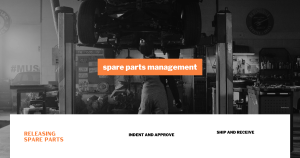We went live with one of the most comprehensive implementations of spare parts management in a service CRM recently.
In this post, I will explain the standard workflows that exist in the system. This will help you understand not only how versatile the system is but also, what it does not currently do. Please leave your comments below if you see any opportunities for us to improve. As you know, you can always register for a free trial and check out – not just the spares management module but the entire sales and service CRM.
Guidelines for releasing spare parts, movement and use:
Part number and serial number
Spare parts management for maintenance is really important in any service organization. All equipment may require spare parts during maintenance. All spare items have a part no. They would also have a description. The same part might be used to repair different equipment. Thus, you can optionally map the same part to one or many pieces of equipment. Needless to say, a single piece of equipment may require multiple spare parts.
Parts may or may not have a serial no. Normally you would have serial numbers for high value components or modules used as spares. But, Saleswah handles both the scenarios equally well. Where parts have serial numbers and where parts do not have serial numbers. It is admin configurable so you can define a category of parts as needing serial numbers and Saleswah would handle it.
Who does this tagging help? Obviously, it makes the job of the frontline technician a lot easier.
Who plays an important role in spare parts management ?
An important role is played in spare parts management for maintenance by all front line executives and managers. They can indent for spares and use them to solve service tickets. Other than them, there are 2 roles in the system who can “load the system” with spare stock.
1. Admin
2. Spares warehouse in-charge
Admin/ Warehouse IC also needs to create the spare models and link them to one or more equipment models.
Any “line executive or manager” in a service role (technician, service exec, or service manager) can indent for spares. Any supervisor can approve parts and ship them. Approvals and shipments can be partial or full. All shipments are made directly to the indenter.
Activities related to spares
There are 2 kinds of indents: those specifically for closing a ticket and those for stocking. Any line executive or manager in the service role can indent for spares and any of his direct managers can approve.
The ticket related indents are treated as urgent by the system and are auto-escalated all the way up if needed to the person who has stock.

The non-ticket related indents- those which are created to stock up locally on frequently used spares- go through the entire approval hierarchy. The idea is that:
- every ticket requires at least one level of approval; so at least your immediate manager must approve.
- if your manager does not approve- it can be that he does not have stock- he can “escalate” the indent to his manager.
- Whoever approved an indent- for part or full items, must ship.
- All indents are visible to everyone up the hierarchy; so, a higher manager has the choice to cut through the layers and directly approve an indent.
Ship and receive: anyone who approves, must ship. It of course may be that while approving the indent you do not have parts; so, you can ship only when you get the parts. You of course need to indent for parts to get them.

If you do not have parts to ship in response to an indent, you can escalate the indent to your manager.
You can ship partially or in full.
The cycle is completed when the indenter receives the parts.
Spare stock inventory and usage: When the parts are received by the indenter, he adds them to his inventory- which is his personal stock of spares. Spares are used in repair and maintenance – always related to a ticket.
So, irrespective of how you received the parts in your stock, you can only use them to solve a ticket.
You have full visibility of the entire spares inventory with you and in your direct reporting chain of service users. You also have visibility into the usages and interesting reports can be generated regarding spares usages for tickets, regions, history of spares used by equipment and by user. This helps you maintain control over spares used and draw conclusions over the maintainability of equipment.
